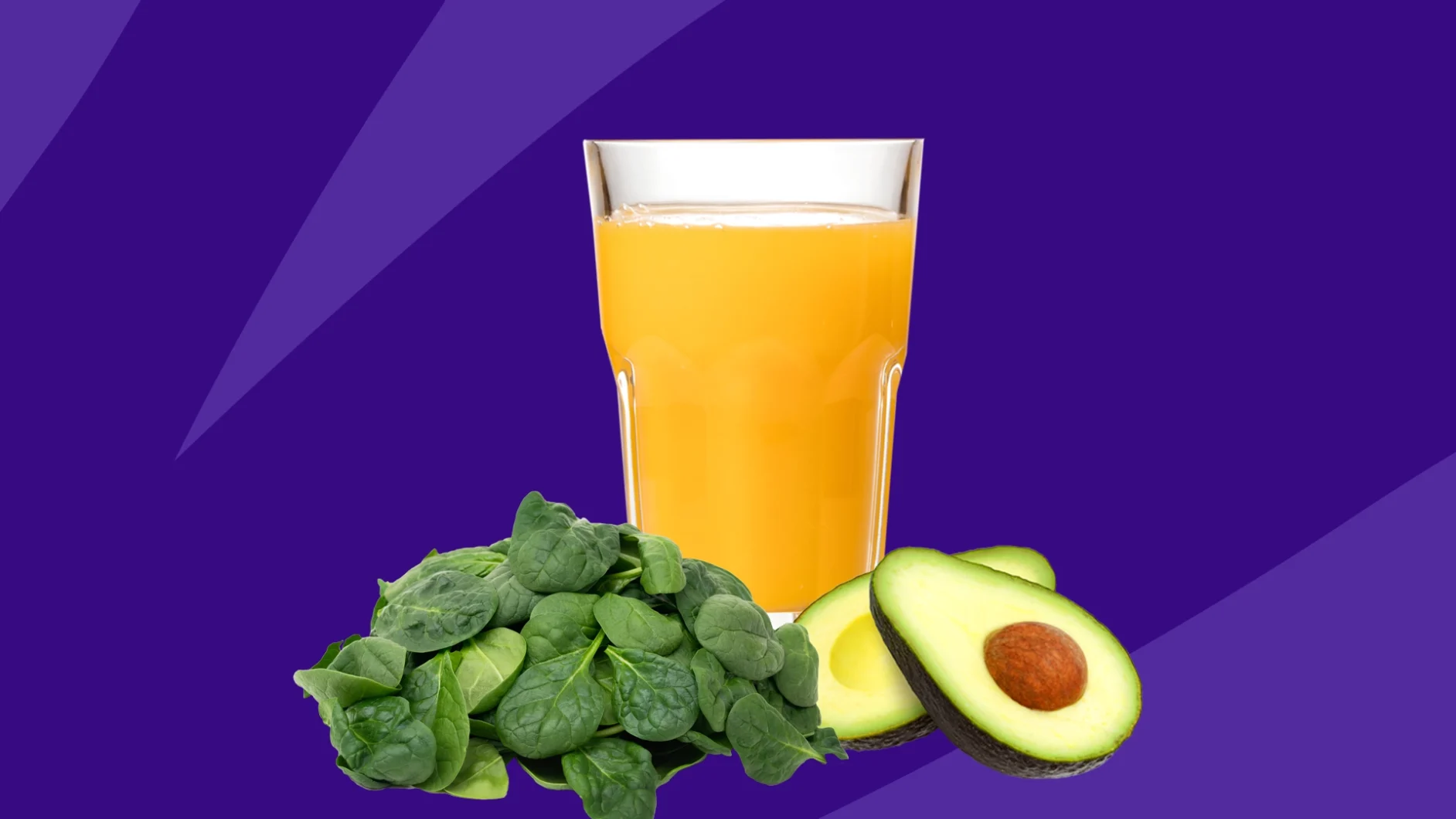Folic acid is the synthetic form of vitamin B9 often added to processed food products like cereal and multivitamin supplements. In its naturally occurring form, vitamin B9 is called folate. “Folic acid plays a critical role in our health by promoting the formation of new, healthy red blood cells, which are vital for oxygen transportation in our bodies,” says Kelsey Costa, MS, RDN, a registered dietitian and nutrition consultant for Consumer Health Digest. Your body needs folate to make DNA and other genetic material. It also helps prevent birth defects when taken during pregnancy.
Most people in the United States get enough vitamin B9, according to the National Institutes of Health Office of Dietary Supplements; however, certain people, such as those with nutrition absorption disorders, alcoholism, pregnant women and teens, those with poor nutrition, many elderly, and females ages 14 to 30 years, are more likely to have challenges with sufficient folate intake. Luckily, there are easy ways to get more folate by adding these folate-rich foods to your diet.
10 folate-rich foods
“Current recommendations for folic acid intake are to get the minimum daily amount of 400 mcg daily for adults,” says John Sosa, MD, a primary care physician in Tampa, Florida.
To meet your daily requirements, you can eat these foods that contain high amounts of folate or folic acid.
1. Legumes
Legumes are nutritional powerhouses. They are low in fat, rich in proteins, and have no cholesterol. Common legumes include black beans, garbanzos, lentils, kidney beans, black-eyed peas (also known as cowpeas), and pinto beans.
According to the USDA National Nutrient Database, a cup of cooked black beans without salt contains about 861 micrograms (mcg) of folate, i.e., about double your daily value. Legumes are also great sources of fiber, which is beneficial for gut health, and according to a 2020 study, consuming legumes may help manage blood sugar in people with diabetes mellitus. Also, a diet rich in legumes reduces the risk of diabetes mellitus.
2. Beef liver
Liver is an organ meat that has significant health benefits because it is packed with nutrients like protein and micronutrients like vitamin A, vitamin B12, iron, riboflavin, calcium, and copper. It is also one of the richest food sources of folate. About 3 ounces (85 g) of cooked, braised beef liver contains approximately 215 mcg of folate.
Consuming beef liver may benefit bone health, vision, and blood cells—as it is rich in calcium, vitamin A, and iron needed to strengthen the bones, maintain the healthy functioning of eye structures, and maintain healthy red blood cells.
3. Asparagus
A cup of boiled asparagus contains about 268 mcg of folate. Other nutrients and antioxidants it contains include calcium, magnesium, phosphorus, sodium, potassium, fluoride, and vitamins A, C, and K. Asparagus is a low-calorie food that can help with weight loss.
4. Spinach
Dark green leafy vegetables like spinach are great sources of folate. When cooked, a cup of spinach contains about 263 mcg of folate, including other macro- and micronutrients like carbohydrates, iron, protein, fiber, calcium, potassium, sodium, vitamin A, vitamin K, beta-carotene, lutein, and zeaxanthin. The natural antioxidants contained in this vegetable help counteract free radicals, which help reduce inflammation and inhibit the growth of cancer cells.
Spinach is also an inorganic nitrate source, which scientific evidence indicates may be good for cardiovascular health. A 2015 study suggests that this veggie’s high nitrate content may reduce blood pressure.
5. Passion fruit
A cup of passion fruit contains about 19.8 g of folate, according to the USDA. Yet, a 2019 study found that a half cup of yellow passion fruit had as much as 300 mcg of folate. The study, however, did not investigate the possible impact of factors like soil properties, maturity, and climate on the total folate content of the plants analyzed. Yellow passion fruit also contains fiber, sugars, phosphorus, water, potassium, magnesium, and antioxidants.
6. Guava
Guava is a tropical fruit that is rich in fiber, vitamin C, and numerous phytonutrients. About 100 grams of this fruit contains about 49 mcg of folate, 228 mg of vitamin C, 22 mg of magnesium, and 417 mg of potassium.
A 2017 review of studies found that guava may help treat or manage medical conditions like diabetes, gastrointestinal infections, and other infectious diseases. Still, more research needs to be done to confirm these benefits.
7. Fortified foods
By the 1980s, researchers realized the link between inadequate folic acid consumption during pregnancy and neural tube abnormalities like spina bifida and anencephaly. This prompted health organizations, including the U.S. Food and Drug Administration (FDA), to encourage manufacturers to fortify food products like bread, flour, cereals, pasta, rice, corn masa, and cornmeal with up to 100 micrograms of folic acid per 100 grams. For example, 1.5 cups of Honeycomb cereal contains 100 mcg of folate, 94 mcg of folic acid, and other vitamins, according to the USDA.
8. Brussels sprouts
Brussel sprouts belong to the brassica family, which includes broccoli, kale, and cauliflower. They are cruciferous vegetables that can be consumed raw or cooked. They are highly nutritious and can be incorporated into many different meals. A cup of Brussels sprouts (78 g) contains about 94 mcg of folate, along with fiber, carbohydrates, protein, vitamins, minerals, and antioxidants.
According to a 2022 study, cruciferous vegetables like Brussels sprouts contain phytochemicals called glucosinolates, which have anti-cancer properties. They may also have protective effects against other medical conditions such as diabetes, hypertension, and cardiovascular diseases.
9. Avocado
Avocados contain a high amount of folate—as much as 163 mcg per serving. Avocados are packed with fiber, nutrients, and healthy fat. They can be part of a nutritious meal for most people, including those trying to lose weight because studies indicate their high fiber content may help decrease hunger and increase satiety. Other nutrients contained in avocados include protein, carbohydrates, calcium, sodium, potassium, vitamin C, vitamin K, and polyunsaturated and monounsaturated fatty acids.
10. Oranges and orange juice
Citrus fruits like oranges are also good sources of folate. One large orange contains about 55 mcg of folate, along with vitamins C and A, fiber, potassium, calcium, and magnesium. Oranges also have a high water content, which is great for hydration. It’s important to note that if you eat the fruit, you’ll benefit from the healthy fiber it contains, which doesn’t come from drinking orange juice.
Folic acid vs. folate
Folic acid and folate are both water-soluble forms of vitamin B9. Folic acid is the synthetic form of folate found in vitamin supplements. Folate is its natural form found in food. However, unlike some supplements, folic acid is easily absorbed and utilized by the body even when taken without food.
“This superior bioavailability is attributed to the fact that folic acid is not subject to the complex breakdown and conversion processes that natural folate undergoes in the digestive system,” Dr. Costa explains. Hence, folic acid supplementation is a reliable way to ensure adequate folate levels, particularly in populations where dietary intake might be insufficient. Folic acid is available both as over-the-counter supplements and prescription medication. It also comes in different forms, including tablets, liquids, and injectables.
RELATED: How to make sure you absorb your supplements
Folic acid benefits
When pregnant women take folic acid, it aids in the proper development of a fetus’s skull, brain, and spinal cord and helps prevent neural tube and genetic defects. But the nutrient also is helpful for people who are not pregnant. Folic acid can:
- Treat iron deficiency anemia when combined with combined with ferrous sulfate.
- Decrease cancer risk.
- Reduce side effects of methotrexate, a medication used for treating inflammatory arthritis and other inflammatory conditions.
- Decrease homocysteine levels in people with high levels of this amino acid and in people with kidney failure.
- Help with mood regulation and may improve symptoms of depressive disorders when taken with antidepressants.
Additionally, people who don’t get enough folate may also experience symptoms such as reduced sense of taste, diarrhea, numbness and tingling in the feet and hands, and muscle weakness, according to Dr. Sosa. This is known as megaloblastic anemia. Folate deficiency may also cause mouth sores and discoloration of hair, skin, and fingernails. Consuming adequate amounts can avoid these unpleasant symptoms.
How much folic acid do you need?
The average daily intake of folic acid recommended for individuals varies depending on age and phase of life. According to the Dietary Guidelines for Americans, the recommended dietary allowance (RDA) for folate is:
- Infants between 6-11 months: 80 mcg of folate
- Babies between 1-3 years: 150 mcg of folate
- Children between 4-8 years: 200 mcg of folate
- Children between 9-13 years: 300 mcg of folate
- Teenagers between 14-18 years: 400 mcg of folate
- Adults ages 19 and older: 400 mcg of folate
- Pregnant people: 600 mcg of folate
- Breastfeeding women: 500 mcg of folate
For women who are trying to conceive, it is important that they increase their daily folate intake to 600 mg. While health experts encourage people to take the recommended amount of folic acid daily, consumers should stick to the RDA or speak to their healthcare provider before supplementing with folic acid to avoid taking too much. Also, folate can interfere with the normal mechanism of some medications (such as anti-seizure or gastrointestinal medications), so it is important to consult your healthcare provider befores taking folate supplements.
“Doses over 1,000 micrograms per day can be associated with an upset stomach, nausea, diarrhea, confusion, behavioral changes, skin reactions, seizures, and other side effects, cancer, and heart disease risk,” Dr. Sosa says.
Consider consulting with your healthcare provider or a registered dietitian to make sure you’re getting the right amount of nutrients your body needs daily.
Sources
- Folate, National Institutes of Health Office of Dietary Supplements (2022)
- Folic Acid Deficiency, StatPearls (2023)
- Dietary Guidelines for Americans 2020-2025, U.S. Department of Agriculture and U.S. Department of Health and Human Services (2020)
- USDA National Nutrient Database for Standard Reference Legacy, United States Department of Agriculture (USDA) (2018)
- FoodData Central U.S. Department of Agriculture
- The Effects of Legume Consumption on Markers of Glycaemic Control in Individuals with and without Diabetes Mellitus: A Systematic Literature Review of Randomised Controlled Trials, Nutrients (2020)
- Promising Tropical Fruits High in Folates, Foods (2019)
- Psidium guajava: A Single Plant for Multiple Health Problems of Rural Indian Population, Pharmacognosy Reviews (2017)
- Folic Acid Fortification: Fact and Folly, U.S. Food and Drug Administration
- Food Standards: Amendment of Standards of Identity For Enriched Grain Products to Require Addition of Folic Acid, Federal Register (1996)
- Women Need 400 micrograms of Folic Acid Every Day, Centers for Disease Control and Prevention (2022)
- About folic acid, NHS (2022)
- Folate and Its Significance in Depressive Disorders and Suicidality: A Comprehensive Narrative Review, Nutrients, (2023)
- Folic Acid, Office of the Assistant Secretary for Health: Office on Women’s Health. (2021)
- Calcium Intake in Bone Health: A Focus on Calcium-Rich Mineral Waters. Nutrients (2018)
- A Red Carpet for Iron Metabolism, Cell, (2017)
- The Role of Vitamin A in Retinal Diseases, International Journal of Molecular Sciences, (2022)
- Protective roles of inorganic nitrate in health and diseases, Curr Med (2022)
- Effect of Spinach, a High Dietary Nitrate Source, on Arterial Stiffness and Related Hemodynamic Measures: A Randomized, Controlled Trial in Healthy Adults, Clinical Nutrition Research (2015)
- Biological Effect of Different Spinach Extracts in Comparison with the Individual Components of the Phytocomplex, Foods (2021)
- Cruciferous Vegetables and Their Bioactive Metabolites: from Prevention to Novel Therapies of Colorectal Cancer, Evidence-based Complementary and Alternative medicine (2022)
- Influence of Cooking Methods on Bioactive Compound Content and Antioxidant Activity of Brussels Sprouts, Preventive Nutrition and Food Science (2017)
- Hass Avocado Inclusion in a Weight-Loss Diet Supported Weight Loss and Altered Gut Microbiota: A 12-Week Randomized, Parallel-Controlled Trial, Current Developments in Nutrition (2019)
- Antiinflammatory and ROS Suppressive Effects of the Addition of Fiber to a High-Fat High-Calorie Meal, The Journal of Clinical Endocrinology & Metabolism (2017)











